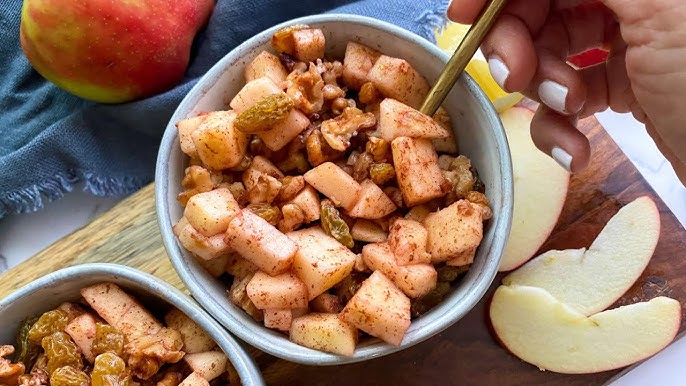Charoset Recipe: Charoset is a beloved dish central to Jewish culinary traditions, especially during Passover. This sweet, chunky mixture, often made from fruits, nuts, and spices, is a symbolic representation of the mortar used by Israelites when they were enslaved in Egypt. More than just a symbolic dish, Charoset is also a flavorful addition to any Seder table.
Its taste and texture vary widely depending on cultural traditions, ranging from smooth pastes to coarsely chopped mixes, but its sweet, spiced undertones remain a constant.
History of Charoset
Charoset’s origins trace back thousands of years to the time of the Exodus. The dish’s symbolic significance stems from its role in the Passover Seder, where it reminds participants of both suffering and resilience.
Over centuries, regional adaptations have emerged. Ashkenazi Jews from Eastern Europe typically favor apple and walnut-based Charoset, while Sephardic Jews in the Mediterranean region incorporate dates, figs, and raisins.
Key Ingredients of Charoset
- Fruits: Apples, dates, figs, or raisins are common.
- Nuts: Walnuts and almonds are often used for their crunch.
- Sweeteners: Honey or sugar adds the desired sweetness.
- Wine: Red wine enhances the flavor and provides moisture.
- Spices: Cinnamon is the star spice, lending warmth and aroma.
These ingredients aren’t just for taste—they carry symbolic meanings tied to the story of Passover.
Types of Charoset Recipes
- Ashkenazi-Style Charoset: This variation uses apples, walnuts, and cinnamon, blended with a touch of red wine. It is coarser in texture and sweet with hints of spice.
- Sephardic-Style Charoset: Richer and more complex, this version incorporates dried fruits like dates and figs, often forming a paste-like consistency.
- Modern Twists: Many contemporary recipes include tropical fruits, nuts, or even chocolate for a creative spin.
Step-by-Step Guide to Making Charoset
Making Charoset is straightforward but requires attention to balance and texture. Follow these steps:
Equipment Needed:
- A cutting board and knife
- A food processor (optional)
- A mixing bowl
- Measuring cups and spoons
Basic Recipe:
- Chop or blend fruits and nuts to the desired texture.
- Mix with cinnamon, honey, and a splash of wine.
- Taste and adjust sweetness or spice as needed.
How to Make Ashkenazi Charoset
Ingredients:
- 4 medium apples (preferably sweet varieties like Gala or Fuji)
- 1 cup chopped walnuts
- 1-2 teaspoons ground cinnamon
- 2-3 tablespoons honey (adjust to taste)
- 1/4 cup sweet red wine (like Manischewitz)
Step-by-Step Instructions:
- Prepare the Apples: Peel and core the apples. Chop them finely for a chunky texture or pulse them in a food processor for a smoother consistency.
- Add the Nuts: Coarsely chop walnuts or pulse them in a food processor, ensuring they maintain some crunch. Combine the apples and nuts in a mixing bowl.
- Season and Sweeten: Sprinkle the mixture with ground cinnamon and drizzle honey over it. Mix thoroughly to evenly distribute the flavors.
- Incorporate the Wine: Gradually pour in the sweet red wine, stirring as you go, until the mixture reaches your desired consistency.
- Taste and Adjust: Adjust sweetness or spice as needed. Some prefer more cinnamon for an added kick.
- Chill Before Serving: Allow the Charoset to sit in the refrigerator for at least 30 minutes before serving. This helps meld the flavors together beautifully.
How to Make Sephardic Charoset
Ingredients:
- 1 cup pitted dates
- 1/2 cup dried figs
- 1/2 cup raisins
- 1/2 cup almonds or pistachios
- 1 teaspoon ground cinnamon
- 2 tablespoons honey
- 1/4 cup orange juice or sweet red wine
Step-by-Step Instructions:
- Prepare the Dried Fruits: Soak dates, figs, and raisins in warm water for 10-15 minutes to soften them. Drain and pat dry.
- Blend the Base: Place the dried fruits in a food processor and blend until they form a thick paste.
- Add Nuts and Seasonings: Coarsely chop almonds or pistachios and mix them into the fruit paste. Sprinkle in the cinnamon and drizzle with honey.
- Adjust the Consistency: Slowly add orange juice or red wine, mixing until the paste reaches a spreadable yet thick texture.
- Chill and Serve: Transfer the mixture to a serving dish, cover, and refrigerate for a few hours to allow the flavors to meld.
Creative Twists on Charoset Recipes
- Nut-Free Charoset: Replace nuts with sunflower seeds or omit them altogether for a nut-free version.
- Tropical Charoset: Add mango, pineapple, or coconut for a tropical twist that brings a fresh, fruity dimension.
- Spiced Charoset: Experiment with additional spices like nutmeg, cardamom, or ginger for a unique flavor profile.
- Chocolate Charoset: Incorporate a handful of cocoa nibs or a drizzle of melted dark chocolate for a decadent version.
Tips for Serving Charoset
- Traditional Presentation: Serve Charoset in a decorative bowl as part of the Seder plate.
- Creative Uses:
- Spread Charoset on matzo for a quick snack.
- Use it as a topping for yogurt or oatmeal.
- Pair it with cheese or roasted meats for a fusion of sweet and savory flavors.
- Garnishing Ideas: Garnish with chopped nuts, a sprinkle of cinnamon, or a drizzle of honey for an appealing finish.
Storing and Reusing Charoset
- Storage Tips: Keep leftover Charoset in an airtight container in the refrigerator for up to five days.
- Repurposing Leftovers:
- Use it as a filling for pastries or turnovers.
- Stir it into pancake or waffle batter.
- Blend it into smoothies for added sweetness and nutrients.
Common Mistakes to Avoid When Making Charoset
- Over-Blending Ingredients: A fine paste can rob Charoset of its desired texture. Aim for a balance of smooth and chunky.
- Using the Wrong Proportions: Too much liquid can make the Charoset runny, while too little may leave it dry. Adjust as needed.
- Neglecting Regional Variations: Ignoring traditional ingredients may detract from the cultural authenticity of the dish.
Health Benefits of Charoset
- Rich in Fiber: Fruits like apples and dates provide a significant fiber boost.
- Packed with Antioxidants: Ingredients such as cinnamon, nuts, and raisins are antioxidant-rich, supporting overall health.
- Natural Sweetener: Charoset uses natural sweeteners like honey and dried fruits, making it a healthier dessert option.
Exploring Charoset Around the World
- Middle Eastern Variations: Often spiced with cardamom and blended with local nuts like pistachios.
- American Adaptations: Includes cranberries and pecans for a local twist.
- European Influences: Often incorporates pears or hazelnuts, showcasing regional fruits and nuts.
FAQs About Charoset Recipe
1. What is Charoset?
Charoset is a traditional Jewish dish often served during Passover. It’s a sweet mixture made with fruits, nuts, spices, and sometimes wine, symbolizing the mortar used by the Israelites during their time in Egypt.
2. What ingredients are typically used in Charoset?
Common ingredients include apples, walnuts, dates, raisins, cinnamon, and red wine. Variations exist based on cultural traditions, such as Sephardic recipes using figs, almonds, and honey.
3. Can Charoset be made ahead of time?
Yes! Charoset can be prepared a day or two in advance. In fact, allowing it to sit enhances the flavors. Store it in an airtight container in the refrigerator until ready to serve.
4. Is Charoset gluten-free?
Most Charoset recipes are naturally gluten-free. However, always double-check the ingredients, especially if using pre-packaged products like wine or dried fruits, to ensure they are certified gluten-free.
5. How should Charoset be served?
Charoset is traditionally served as part of the Passover Seder plate. It can also be enjoyed as a spread on matzah or even as a topping for desserts like yogurt or ice cream.
6. Can I customize my Charoset recipe?
Absolutely! Charoset recipes are highly versatile. Feel free to adjust the sweetness, add your favorite nuts, or include different fruits to suit your taste preferences.
Conclusion
Charoset is far more than a symbolic dish—it’s a celebration of flavor, tradition, and history. Whether you prefer a chunky Ashkenazi-style version or a paste-like Sephardic Charoset, there’s a recipe to suit every palate. Experiment with variations, serve it with pride, and enjoy its rich cultural significance during your Seder and beyond.



